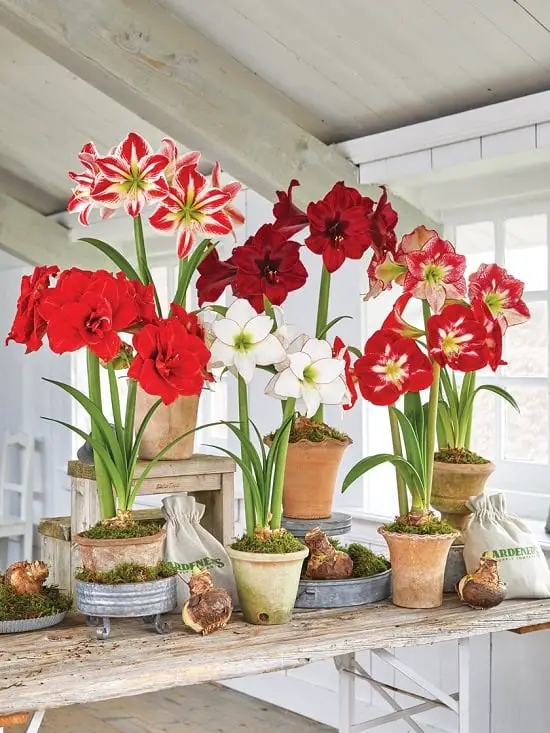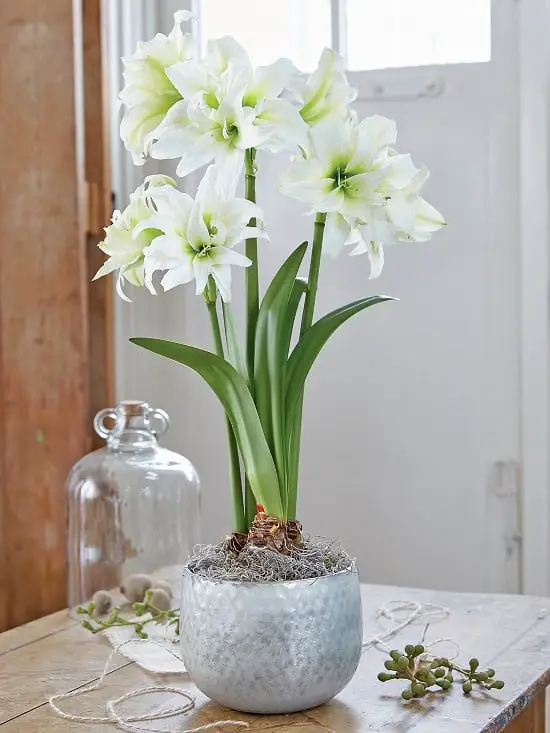Grow Amaryllis in Pots Indoors for a stunning display of its colorful flowers.

Amaryllis is native to Peru and South Africa. Its name is derived from the Greek word ‘Amarysso,’ which means ‘to sparkle.’ The flowers can be single or double, up to 4 to 10 inches.
They mainly come in red and white but are also available in salmon, pink, apricot, rose, or deep burgundy. If you have liked reading about it so far, scroll down to learn about Growing Amaryllis Indoors!
Check out our article on different types of bromeliads to grow indoors here!
Some of the Best Amaryllis Varieties
- Samba This stunning variety offers ruffled red flowers with white markings and borders. It can reach up to 18-22 inches tall.
- Apple Blossom is a combination of candy pink and snowy white flowers on lime green stems.
- Red Lion has velvety-red flowers adorned with white stamens.
- Faro features delicate pale salmon and white flowers.
- Monaco displays a white-green center on large red flowers.
- Summertime produces 7-10 inch flowers that color from watermelon pink to deep rose with a green center and cranberry rays.
- Fairy Tale shows off striped red and white flowers on slender stems.
- Matterhorn has large snow-white flowers with a yellow-green center.
- Ice Queen showcases beautiful, furled white flowers with green throats.
Choosing a Container
A pot measuring 6-8 inches deep and 4-5 inches wide will be sufficient. To add to the beauty of its flowers, use decorative ceramic pots! Using glass vases and mason jars can also be a great idea!
Just make sure that they are atleast 2-3 inches wider than the bulb. Also, don’t forget that pots with drainage holes are better as the amaryllis bulb develops rot in soggy conditions.
Choosing the Bulbs
One bulb of the amaryllis plant develops two stems, producing four flowers each. If you are looking forward to having big flowers, then get your hands on the biggest bulb you can find! You can get them online or at a garden center/nursery near you.
Planting Amaryllis

You can plant amaryllis anytime between October and April.
Before planting the bulb, soak it in lukewarm water. 3-5 hours would be enough! Fill the pot with compost-rich soil mix and carefully plant the bulb into it. Ensure you are not damaging any part of it in the process.
Pack the soil gently around the bulb, covering it till its neck, not above. Keep the soil moist and water regularly. Do not let the soil dry out completely. Keep the pot in a spot where it receives indirect light and several hours of direct sun, too.
Requirements for Growing Amaryllis Indoors

Location
Place the pot where it receives a mix of direct and indirect daylight. A window that receives all-day-long indirect light and a few hours of the mild morning sun will be an ideal choice, as amaryllis loves growing in partial sun.
Soil
Amaryllis dislikes wet and soggy soil; hence, make a light soil mix by adding two-parts loam and one part rotted aged manure. You can also mix one part sand, one part compost, and one part loam to create the right balance of well-draining soil.
Water
Water your indoor amaryllis plant when the topsoil feels dry. You can poke your finger to feel the moisture in the growing medium or use a moisture meter. Don’t allow the plant to stand in water, as wet soil promotes root rot and invites pests.
Amaryllis Care

Fertilizer
You can fertilize the plant every 3-4 weeks using a balanced liquid fertilizer. Do follow the instructions on the label for directions. You can also go for a blossom booster fertilizer.
Re-potting
You will have to re-pot the plants when the bulbs start to outgrow the pot. The best time is when the plant is dormant. Go for a pot that’s atleast 3-4 inches wider than the bulb. Plant only two-thirds of the bulb into the soil.
Pruning & Deadheading
Cut the old flowers, using a gardening shear or scissors, from the stem after flowering. Also, cut the sagging stems back to the top of the bulb.
Pests and Diseases
Checking the bulbs carefully when buying may reduce the chance of infestation. Red blotch can impact both the health and appearance of the amaryllis.
Small red or pink patches may appear on the bulb’s skin, resulting in a weak, easily breakable flower stalk. Aphids can also be seen on the plants’ stems, but you can easily control them when growing them indoors.
Plant the bulbs in fresh potting soil in a sterile pot. Use a fungicide to treat the plant if the disease persists.
How to Cut Amaryllis Flowers?
Amaryllis looks stunning as a cut flower. However, you have to take good care of them once cut.
- Using a sharp knife, cut the flower at a 45-degree angle. Put the stalk upside down and fill the hollow stems with water. Seal the opening with cotton.
- Get a clean vase, fill it with water, and place the flowers. You can also add cut-flower food to it.
- Change the water every 2-3 days for both the stem and vase.
- With proper care, the flowers will last for 7-10 days.
Can You Grow Amaryllis Year-Round?
After the plant is done flowering, prune the blossoms, making sure you keep the leaves attached. After the last frost, move it outdoors and keep it in dappled sunlight. Water it till September, and then take the plant to a cool, dark place.
A closet or basement is going to be an apt choice. The plant will go into a dormant period. In December, keep it at a sunny location and start watering. The plant will flower again!
Amaryllis Toxicity
The plant contains the alkaloid lycorine, which is toxic to pets. So, if you have a dog or cat in your house, be careful. If ingested, it can cause drooling, vomiting, loss of appetite, and diarrhea. Contact a veterinarian immediately if your pet swallows amaryllis.



śą piękne,ale mnie nie udaje się ,aby zakwitły ponownie;E.